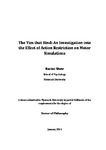The Ties that Bind: An Investigation into the Effect of Action Restriction on Motor Simulations
| dc.contributor.supervisor | Tucker, Mike | |
| dc.contributor.author | Shaw, Rachel | |
| dc.contributor.other | School of Psychology | en_US |
| dc.date.accessioned | 2015-01-23T13:13:05Z | |
| dc.date.available | 2015-01-23T13:13:05Z | |
| dc.date.issued | 2014 | |
| dc.identifier | 237666 | en_US |
| dc.identifier.uri | http://hdl.handle.net/10026.1/3206 | |
| dc.description | Full version unavailable due to 3rd party copyright restrictions. | |
| dc.description.abstract |
This thesis examines the relationship between physical capabilities and the mental simulation of actions. Behavioural research suggests that the ability to understand of an action is directly related to the ability to perform it, an idea consistent with the Embodied theory of Cognition. The present work aims to further explore the relationship between the body and cognition and investigate whether the restriction of an action or movement disrupts the simulation of movements during motor imagery tasks, which have been shown to elicit motor activations upon performance. This theory was investigated in a series of seven motor simulation experiments during which participants’ movements were restrained. Studies 1-3 investigated simulations that occur unconsciously through the observation of manipulatable objects. Studies 4-6 investigated simulations that occur during performance of mental transformations of manipulatable objects and body part stimuli. The results of these studies found no significant difference in performance when movement was restricted compared to when free to move. Study 7 investigated simulations that occur consciously through the observation of actions performed by another individual and found a significant effect of restriction on performance. The findings of these studies indicate that the ability to perform a movement is required for the accurate simulation of actions when an action is being observed but not when a simulated action is required on a stationary object, which suggests a variable relationship between the body and cognitive processes. This thesis offers an interesting contribution to the Embodied Cognition debate and provides a further insight into the relationship between the motor and visual systems. | en_US |
| dc.language.iso | en | en_US |
| dc.publisher | Plymouth University | en_US |
| dc.subject | Vision | |
| dc.subject | Action | |
| dc.subject | Embodied cognition | en_US |
| dc.title | The Ties that Bind: An Investigation into the Effect of Action Restriction on Motor Simulations | en_US |
| dc.type | Thesis | |
| plymouth.version | Edited version | en_US |
| dc.identifier.doi | http://dx.doi.org/10.24382/4785 | |
| dc.identifier.doi | http://dx.doi.org/10.24382/4785 |
Files in this item
This item appears in the following Collection(s)
-
01 Research Theses Main Collection
Research Theses Main


